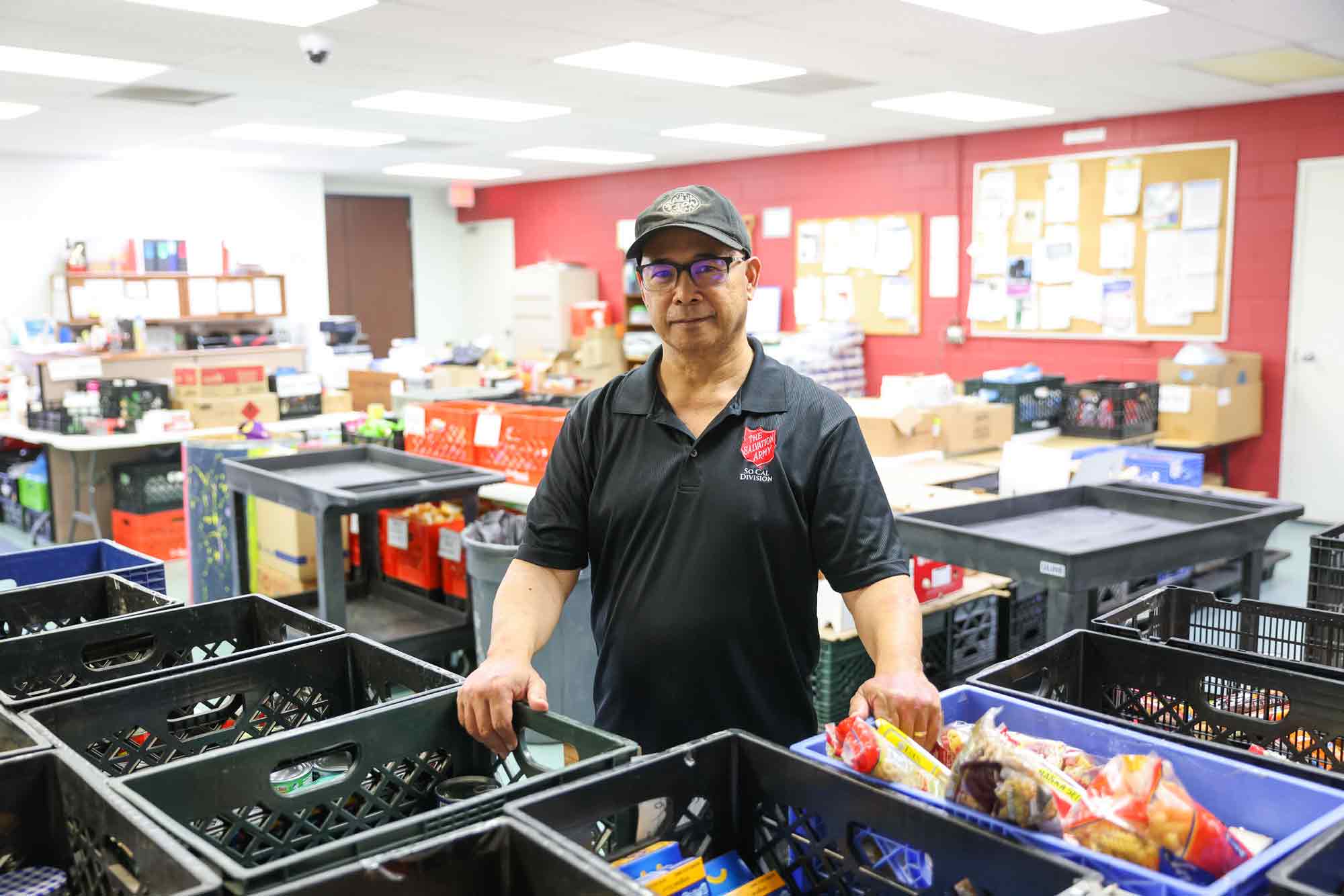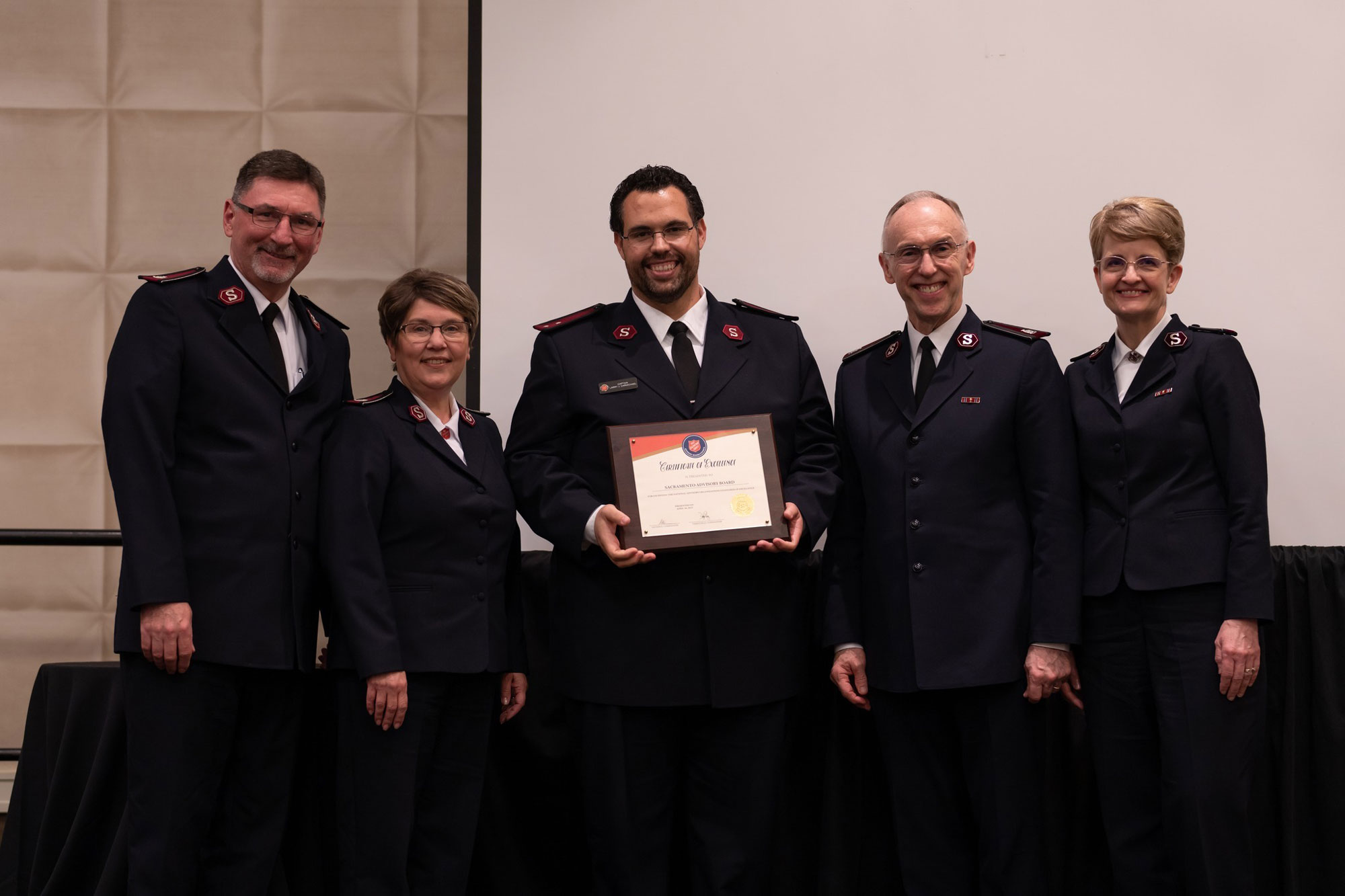Listen to this article
Listen to this article
Loading
Play
Pause
Options
0:00
-:--
1x
Playback Speed- 0.5
- 0.6
- 0.7
- 0.8
- 0.9
- 1
- 1.1
- 1.2
- 1.3
- 1.5
- 2
Audio Language
- English
- French
- German
- Italian
- Spanish
Open text
at the salvation army, food is just the beginning of meeting need. the salvation army provided more than 171 million meals to individuals and families in need last year—always with a goal to not only help but connect. the salvation army stillman sawyer family services center in harbor city, california, distributes some 400 monthly grocery orders to individuals and families in need. and in the 11 years center director ernesto madrid has worked on the frontlines here, he’s learned that sometimes needs are best met outside “business hours,” especially when it’s a first-time request for help. “a lot of people are eating their pride just to show up here,” madrid said. “some even ask us, ‘can i make a special arrangement? can i come at six in the evening—you know, when nobody’s there? can i be there at seven in the morning?’”. he is willing to accommodate their requests. “i do it because this gives me a chance to hear their stories,” he said. “and that’s everything. that’s how i learn how to help them further.”. madrid doesn’t just hand out food and send people on their way. he invites them to sit down and asks about their life, digging deeper to get beyond the immediate physical need. and he’s not alone. at the salvation army, help might begin with food, but it doesn’t end there. when someone feels safe enough to tell their story, they reveal their humanity—the face behind the food box. from these kinds of connections, the salvation army can offer more hope and practical support. hunger, though, is often what compels people to first seek help. nationwide, more than 33 million people, including 5 million children, are food insecure, according to the usda. of those people, some 13.5 million don’t know where their next meal is coming from. the salvation army is uniquely positioned with a presence in nearly every community across the country to combat hunger and food insecurity wherever it persists. last year, the organization provided more than 171 million meals through food pantries, meal programs, disaster mobilizations and even community gardens to individuals and families in need. each food box or grocery order represents a family or an individual in need—a truth sometimes lost amid such staggering statistics. and while hunger is often associated with homelessness, many experience it: immigrants, single parents, seniors and families affected by job loss, health issues or inflation. at-home food costs alone increased more than 10 percent in the last year, according to the consumer price index. the state of hunger in americanationwide, more than 33 million people, including 5 million children, are food insecure, according to the usda. of those people, some 13.5 million don’t know where their next meal is coming from. so just because someone is housed doesn’t mean they are fed. “shockwaves from the pandemic, international market forces and the on-going housing crisis continue to reverberate, manifesting in the form of misfortunes such as the recent waves of layoffs, spikes in inflation and rising rental costs,” said christopher doughty, western territorial social services research specialist and territorial pathway of hope director. “consequently, we are seeing more people coming to us for help who have never needed to access social welfare before—people having to choose between whether to pay the rent or buy groceries, who are just short of making ends meet. whether it’s providing food directly or covering another expense like a utility bill, we help plug in the gaps in their budget to ensure all of their needs continue to be met in an increasingly expensive environment.”. for madrid, it all comes down to relationships. “hunger—it goes beyond the physical hunger. a lot of people are spiritually hungry…we’re not just giving out food, you know. it’s really the engagement—the trust you slowly build,” he said. he shared the story of one unhoused, 70-year-old man who visits the stillman sawyer center. big and strong, the man has a “tough guy” image and a secret. he writes poetry. “he comes here and shares some of his poetry with me,” madrid said. “we always remind ourselves that we must be ready to listen…if all we did was give out food, we wouldn’t really be doing our job. there wouldn’t be progress in people’s lives. helping someone implement change requires connecting with them and listening to their story, building a relationship grounded in trust. “if we’re actually helping them, the connection becomes a partnership and that partnership uplifts them from their situation.”. who are the faces behind the food? these are a few of their stories. getting settled. rita dabechie emigrated from nigeria with her three children in 2018 and settled in southern california. she said they came to the u.s. in search of “greener pastures.”. “i want my children to have a better education,” she said. “i want them to grow up in a more civilized, more developed country than where i came from.”. dabechie is working on her own education, too, at southwest community college in los angeles. while she was getting on her feet, she heard that she could get help at the stillman sawyer family services center in harbor city, california. “this salvation army, they’ve been more of a blessing to people,” she said as she loaded her car with food after also receiving new school backpacks for her kids. “not only to people that live here, but even immigrants, people that came in that don’t know their left from right when they come here. they don’t discriminate. they give things to people.”. making it through. for adam mclaren and danielle (dani) mclaren, times were tough. after a disabling work accident in 2020, adam mclaren searched for a new career after 20 years in the flooring business. by 2022, he was in school full time, studying accounting. in february 2022, the couple welcomed baby jazlynn, who joined 12-year-old brother, keith, and 9-year-old sister, mia. during this time, dani mclaren, a full-time mom, heard from an acquaintance, heather kennedy, who had started working at the salvation army gresham (oregon) corps. “heather said, ‘i know you guys are struggling. we have this food pantry here.’ and i took her up on that,” dani mclaren said. kennedy didn’t stop there. she told mclaren about the corps’ family night, something mclaren had already been searching for so her middle-school aged son could get connected somewhere. today, the mclarens are regulars at the gresham corps’ wednesday family night, where mclaren hangs out with the baby and attends bible study while the two older kids participate in various activities. during the summer, both kids attend camp kuratli at trestle glen, a salvation army camp in boring, oregon. her husband loves wednesday nights, too. “it gives him a chance to do his homework,” mclaren said. he just has one year of school remaining, and recently received straight a’s. mclaren said the experience has changed her outlook on receiving assistance, which she developed experiencing homelessness as a child. “when i’d think of getting help from the church, it’s people not really wanting you there and being proud of themselves for helping but not actually wanting to help you,” she said. “then, going to the salvation army, i was constantly surprised that they’re just looking for ways to help. and they didn’t ask me for anything; they didn’t expect me to do anything for them. they were really kind. and that was really amazing.”. exiting homelessness. tyler triplett was experiencing homelessness in newport, oregon. he’d been unhoused for several years, he said, after losing direction and hope following a divorce. he first came to the salvation army newport corps to pick up food boxes. “that was a huge help,” he said. what he didn’t expect was the connection he developed with corps officer major jennifer erickson-king, who made an effort to get to know him when he stopped by for food. “she was very personable,” he said. “we ended up talking, visiting a bit….she had a different take on things. you know when you go talk to somebody, just to get a different perspective?”. a few months ago he was feeling down after applying for several jobs and getting nowhere. “i was looking for somebody to talk to,” he said, and he went to the salvation army. major raymond erickson-king asked him if he needed anything and offered him a sandwich. although triplett hadn’t interacted much with raymond erikson-king before, he shared his frustration. “he suggested i go to the dollar tree—said they were hiring,” triplett said. “i had never worked in retail. and it wasn’t something that i ever thought i would do. but then like a half an hour later, i found myself in front of dollar tree. i went in and applied and two days later got the job.”. how the salvation army is fighting hungerthe salvation army is uniquely positioned with a presence in nearly every community across the country to combat hunger wherever it persists. last year we provided more than 171 million meals through food pantries, meal programs, disaster mobilizations and even community gardens to individuals and families in need. after working two months as a part-time stocker, he got a promotion—he’s now assistant manager. and he’s confident he’ll be a store manager soon. “i’ve got a solid place to stay now, two blocks away from work which is perfect,” triplett said. “i don’t know. it just all seemed to fit, right about when i needed it.”. when triplett stopped by the newport corps to announce the news, jennifer erickson-king gave god the credit. “we shared with him that this was all god’s amazing plans for him and for all his children, and that we always thank god for his many blessings upon our lives,” erickson-king said. for triplett, it wasn’t the food that made the biggest difference. “what means the most to me about the salvation army is the genuine compassion,” he said, “the caring and the friendship that’s developed down there.”. overcoming inflation. martin and sun partida needed help after sun partida became disabled and could no longer work, leaving the household with just one income in anacortes, washington. while they qualified for food stamps, what they received was not enough to handle rising costs. sun partida knew people were receiving help at the salvation army and decided to give the client-choice food pantry a try. “i didn’t really know what to expect,” she said. “i didn’t want to be seen as a charity case. but they don’t—they don’t treat us like that. they are very open and welcoming, and helpful.”. martin partida said they receive a lot in one visit to the food pantry, enough for three nights worth of meals. “and that sets us up for the week,” he said. as a u.s. army-trained dietician and chef, he makes good use of the food. “i know there’s religious services also, and nobody has tried to pressure us to come,” he said. “that’s pretty refreshing. no pressure at all here.”. do good:. there is a place for you in the salvation army. see more in our annual print edition, “a place of belonging.”. start your day with goodness. get on the list for good words from the good word and get a boost of inspiration in 1 minute a day with a daily affirmation from scripture sent straight to your inbox. a pep-talk for the day. a boost of inspiration and comfort. a bit of encouragement when you need it. get on the list and start receiving what you need today. see how the salvation army fights hunger.
Open context player
Close context player
Plays:-Audio plays count
at the salvation army, food is just the beginning of meeting need. the salvation army provided more than 171 million meals to individuals and families in need last year—always with a goal to not only help but connect. the salvation army stillman sawyer family services center in harbor city, california, distributes some 400 monthly grocery orders to individuals and families in need. and in the 11 years center director ernesto madrid has worked on the frontlines here, he’s learned that sometimes needs are best met outside “business hours,” especially when it’s a first-time request for help. “a lot of people are eating their pride just to show up here,” madrid said. “some even ask us, ‘can i make a special arrangement? can i come at six in the evening—you know, when nobody’s there? can i be there at seven in the morning?’”. he is willing to accommodate their requests. “i do it because this gives me a chance to hear their stories,” he said. “and that’s everything. that’s how i learn how to help them further.”. madrid doesn’t just hand out food and send people on their way. he invites them to sit down and asks about their life, digging deeper to get beyond the immediate physical need. and he’s not alone. at the salvation army, help might begin with food, but it doesn’t end there. when someone feels safe enough to tell their story, they reveal their humanity—the face behind the food box. from these kinds of connections, the salvation army can offer more hope and practical support. hunger, though, is often what compels people to first seek help. nationwide, more than 33 million people, including 5 million children, are food insecure, according to the usda. of those people, some 13.5 million don’t know where their next meal is coming from. the salvation army is uniquely positioned with a presence in nearly every community across the country to combat hunger and food insecurity wherever it persists. last year, the organization provided more than 171 million meals through food pantries, meal programs, disaster mobilizations and even community gardens to individuals and families in need. each food box or grocery order represents a family or an individual in need—a truth sometimes lost amid such staggering statistics. and while hunger is often associated with homelessness, many experience it: immigrants, single parents, seniors and families affected by job loss, health issues or inflation. at-home food costs alone increased more than 10 percent in the last year, according to the consumer price index. the state of hunger in americanationwide, more than 33 million people, including 5 million children, are food insecure, according to the usda. of those people, some 13.5 million don’t know where their next meal is coming from. so just because someone is housed doesn’t mean they are fed. “shockwaves from the pandemic, international market forces and the on-going housing crisis continue to reverberate, manifesting in the form of misfortunes such as the recent waves of layoffs, spikes in inflation and rising rental costs,” said christopher doughty, western territorial social services research specialist and territorial pathway of hope director. “consequently, we are seeing more people coming to us for help who have never needed to access social welfare before—people having to choose between whether to pay the rent or buy groceries, who are just short of making ends meet. whether it’s providing food directly or covering another expense like a utility bill, we help plug in the gaps in their budget to ensure all of their needs continue to be met in an increasingly expensive environment.”. for madrid, it all comes down to relationships. “hunger—it goes beyond the physical hunger. a lot of people are spiritually hungry…we’re not just giving out food, you know. it’s really the engagement—the trust you slowly build,” he said. he shared the story of one unhoused, 70-year-old man who visits the stillman sawyer center. big and strong, the man has a “tough guy” image and a secret. he writes poetry. “he comes here and shares some of his poetry with me,” madrid said. “we always remind ourselves that we must be ready to listen…if all we did was give out food, we wouldn’t really be doing our job. there wouldn’t be progress in people’s lives. helping someone implement change requires connecting with them and listening to their story, building a relationship grounded in trust. “if we’re actually helping them, the connection becomes a partnership and that partnership uplifts them from their situation.”. who are the faces behind the food? these are a few of their stories. getting settled. rita dabechie emigrated from nigeria with her three children in 2018 and settled in southern california. she said they came to the u.s. in search of “greener pastures.”. “i want my children to have a better education,” she said. “i want them to grow up in a more civilized, more developed country than where i came from.”. dabechie is working on her own education, too, at southwest community college in los angeles. while she was getting on her feet, she heard that she could get help at the stillman sawyer family services center in harbor city, california. “this salvation army, they’ve been more of a blessing to people,” she said as she loaded her car with food after also receiving new school backpacks for her kids. “not only to people that live here, but even immigrants, people that came in that don’t know their left from right when they come here. they don’t discriminate. they give things to people.”. making it through. for adam mclaren and danielle (dani) mclaren, times were tough. after a disabling work accident in 2020, adam mclaren searched for a new career after 20 years in the flooring business. by 2022, he was in school full time, studying accounting. in february 2022, the couple welcomed baby jazlynn, who joined 12-year-old brother, keith, and 9-year-old sister, mia. during this time, dani mclaren, a full-time mom, heard from an acquaintance, heather kennedy, who had started working at the salvation army gresham (oregon) corps. “heather said, ‘i know you guys are struggling. we have this food pantry here.’ and i took her up on that,” dani mclaren said. kennedy didn’t stop there. she told mclaren about the corps’ family night, something mclaren had already been searching for so her middle-school aged son could get connected somewhere. today, the mclarens are regulars at the gresham corps’ wednesday family night, where mclaren hangs out with the baby and attends bible study while the two older kids participate in various activities. during the summer, both kids attend camp kuratli at trestle glen, a salvation army camp in boring, oregon. her husband loves wednesday nights, too. “it gives him a chance to do his homework,” mclaren said. he just has one year of school remaining, and recently received straight a’s. mclaren said the experience has changed her outlook on receiving assistance, which she developed experiencing homelessness as a child. “when i’d think of getting help from the church, it’s people not really wanting you there and being proud of themselves for helping but not actually wanting to help you,” she said. “then, going to the salvation army, i was constantly surprised that they’re just looking for ways to help. and they didn’t ask me for anything; they didn’t expect me to do anything for them. they were really kind. and that was really amazing.”. exiting homelessness. tyler triplett was experiencing homelessness in newport, oregon. he’d been unhoused for several years, he said, after losing direction and hope following a divorce. he first came to the salvation army newport corps to pick up food boxes. “that was a huge help,” he said. what he didn’t expect was the connection he developed with corps officer major jennifer erickson-king, who made an effort to get to know him when he stopped by for food. “she was very personable,” he said. “we ended up talking, visiting a bit….she had a different take on things. you know when you go talk to somebody, just to get a different perspective?”. a few months ago he was feeling down after applying for several jobs and getting nowhere. “i was looking for somebody to talk to,” he said, and he went to the salvation army. major raymond erickson-king asked him if he needed anything and offered him a sandwich. although triplett hadn’t interacted much with raymond erikson-king before, he shared his frustration. “he suggested i go to the dollar tree—said they were hiring,” triplett said. “i had never worked in retail. and it wasn’t something that i ever thought i would do. but then like a half an hour later, i found myself in front of dollar tree. i went in and applied and two days later got the job.”. how the salvation army is fighting hungerthe salvation army is uniquely positioned with a presence in nearly every community across the country to combat hunger wherever it persists. last year we provided more than 171 million meals through food pantries, meal programs, disaster mobilizations and even community gardens to individuals and families in need. after working two months as a part-time stocker, he got a promotion—he’s now assistant manager. and he’s confident he’ll be a store manager soon. “i’ve got a solid place to stay now, two blocks away from work which is perfect,” triplett said. “i don’t know. it just all seemed to fit, right about when i needed it.”. when triplett stopped by the newport corps to announce the news, jennifer erickson-king gave god the credit. “we shared with him that this was all god’s amazing plans for him and for all his children, and that we always thank god for his many blessings upon our lives,” erickson-king said. for triplett, it wasn’t the food that made the biggest difference. “what means the most to me about the salvation army is the genuine compassion,” he said, “the caring and the friendship that’s developed down there.”. overcoming inflation. martin and sun partida needed help after sun partida became disabled and could no longer work, leaving the household with just one income in anacortes, washington. while they qualified for food stamps, what they received was not enough to handle rising costs. sun partida knew people were receiving help at the salvation army and decided to give the client-choice food pantry a try. “i didn’t really know what to expect,” she said. “i didn’t want to be seen as a charity case. but they don’t—they don’t treat us like that. they are very open and welcoming, and helpful.”. martin partida said they receive a lot in one visit to the food pantry, enough for three nights worth of meals. “and that sets us up for the week,” he said. as a u.s. army-trained dietician and chef, he makes good use of the food. “i know there’s religious services also, and nobody has tried to pressure us to come,” he said. “that’s pretty refreshing. no pressure at all here.”. do good:. there is a place for you in the salvation army. see more in our annual print edition, “a place of belonging.”. start your day with goodness. get on the list for good words from the good word and get a boost of inspiration in 1 minute a day with a daily affirmation from scripture sent straight to your inbox. a pep-talk for the day. a boost of inspiration and comfort. a bit of encouragement when you need it. get on the list and start receiving what you need today. see how the salvation army fights hunger.
Listen to this article

















